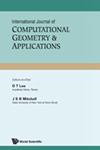Approximate Greedy Clustering and Distance Selection for Graph Metrics
Q4 Mathematics
International Journal of Computational Geometry & Applications
Pub Date : 2015-07-06
DOI:10.20382/jocg.v11i1a25
引用次数: 9
Abstract
$\newcommand{\eps}{\varepsilon}$ In this paper, we consider two important problems defined on finite metric spaces, and provide efficient new algorithms and approximation schemes for these problems on inputs given as graph shortest path metrics or high-dimensional Euclidean metrics. The first of these problems is the greedy permutation (or farthest-first traversal) of a finite metric space: a permutation of the points of the space in which each point is as far as possible from all previous points. We describe randomized algorithms to find $(1+\eps)$-approximate greedy permutations of any graph with $n$ vertices and $m$ edges in expected time $O(\eps^{-1}(m+n)\log n\log(n/\eps))$, and to find $(1+\eps)$-approximate greedy permutations of points in high-dimensional Euclidean spaces in expected time $O(\eps^{-2} n^{1+1/(1+\eps)^2 + o(1)})$. Additionally we describe a deterministic algorithm to find exact greedy permutations of any graph with $n$ vertices and treewidth $O(1)$ in worst-case time $O(n^{3/2}\log^{O(1)} n)$. The second of the two problems we consider is distance selection: given $k \in [ \binom{n}{2} ]$, we are interested in computing the $k$th smallest distance in the given metric space. We show that for planar graph metrics one can approximate this distance, up to a constant factor, in near linear time.图度量的近似贪婪聚类和距离选择
$\newcommand{\eps}{\varepsilon}$ 本文考虑了在有限度量空间上定义的两个重要问题,并在给定输入为图最短路径度量或高维欧几里得度量的情况下,对这两个问题提供了有效的新算法和近似格式。这些问题中的第一个是有限度量空间的贪婪排列(或最远优先遍历):空间中每个点尽可能远离前面所有点的点的排列。我们描述了在期望时间$O(\eps^{-1}(m+n)\log n\log(n/\eps))$内找到任意具有$n$顶点和$m$边的图的$(1+\eps)$ -近似贪婪置换的随机算法,以及在期望时间$O(\eps^{-2} n^{1+1/(1+\eps)^2 + o(1)})$内找到高维欧几里德空间中点的$(1+\eps)$ -近似贪婪置换的随机算法。此外,我们还描述了一种确定性算法,用于在最坏情况时间$O(n^{3/2}\log^{O(1)} n)$内找到具有$n$顶点和$O(1)$树宽的任意图的精确贪婪排列。我们考虑的第二个问题是距离选择:给定$k \in [ \binom{n}{2} ]$,我们感兴趣的是计算给定度量空间中的$k$最小距离。我们证明,对于平面图形度量,可以在接近线性的时间内近似这个距离,直到一个常数因子。
本文章由计算机程序翻译,如有差异,请以英文原文为准。
求助全文
约1分钟内获得全文
求助全文
来源期刊
CiteScore
0.80
自引率
0.00%
发文量
4
审稿时长
>12 weeks
期刊介绍:
The International Journal of Computational Geometry & Applications (IJCGA) is a quarterly journal devoted to the field of computational geometry within the framework of design and analysis of algorithms.
Emphasis is placed on the computational aspects of geometric problems that arise in various fields of science and engineering including computer-aided geometry design (CAGD), computer graphics, constructive solid geometry (CSG), operations research, pattern recognition, robotics, solid modelling, VLSI routing/layout, and others. Research contributions ranging from theoretical results in algorithm design — sequential or parallel, probabilistic or randomized algorithms — to applications in the above-mentioned areas are welcome. Research findings or experiences in the implementations of geometric algorithms, such as numerical stability, and papers with a geometric flavour related to algorithms or the application areas of computational geometry are also welcome.

 求助内容:
求助内容: 应助结果提醒方式:
应助结果提醒方式:


